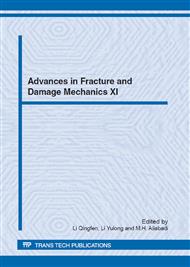p.101
p.105
p.109
p.113
p.117
p.121
p.125
p.129
p.133
The Debond Fracture of Sandwich Plate with Corrugated Core Using Cohesive Zone Element
Abstract:
In this paper, flatwise tensile test (FWT) and modified double cantilever beam (DCB) experiment were conducted to investigated the debond fracture of sandwich plate with corrugated core. In the experiment, the crack always stays at the face/core interfacial. Tensile bond strength of face core can be given from the flatwise tensile test and we can get the mode I fracture toughness GIC from DCB tests. It is found that the trends of curves change greatly at the beginning, with the propagation of crack, load against open displacement curves change smoothly. In order to simulate the face/core failure of sandwich plate with corrugated core, the cohesive element model is used. Tensile strength and strain energy release rate measured by the experiments presented in this paper are used in as parameters for simulation of the debond fracture. By comparing with the experiment results, the model can express the face/core failure of sandwich plate with corrugated core validly.
Info:
Periodical:
Pages:
117-120
Citation:
Online since:
November 2012
Authors:
Price:
Сopyright:
© 2013 Trans Tech Publications Ltd. All Rights Reserved
Share:
Citation:


